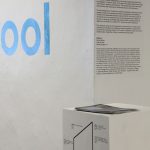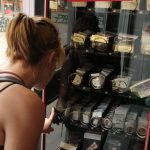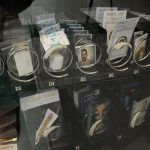Here is a page added for the Credos project, which just had to be postponed: http://www.conceptualyouthhostel.net/credos/
published March 31, 2020
Here is a page added for the Credos project, which just had to be postponed: http://www.conceptualyouthhostel.net/credos/
published March 31, 2020
In the summer of 2017, the Readymade Institution course, led by Michael McCormack and Michael Eddy, organized an exchange project between Think School, an independent art course in Sapporo, Japan, and the Readymade Institution, NSCAD University. Each class installed the work of the other. Exhibition views from the Readymade Institution show in Public Art Research Center in Sapporo, Japan ↓
I showed a Japanese-translated version of Protest Debate.
Exhibition views from Think School show in Anna Leonowens Gallery 3 ↓
Think School exhibition announcement:
The Readymade Institution class presents Think School
Anna Leonowens Gallery 3
NSCAD University Fountain campus
August 14, 2017—August 19, 2017

Think School is a small, independently run art course organized by artists in the city of Sapporo, in Northern Japan. Their motto (in the speech bubble of their logo) is “Art school to make the city interesting.” Their classes meet once a week and feature lectures and workshops on various themes around art and culture.
For this exchange show, Think School students and teachers were given an open mandate, whose only constraints were those of transportation and translation. Students in the Readymade Institution Class at NSCAD U act as the curators of the received work, and collectively work out the arrangement and mediation of the show.
In exchange, the Readymade Institution Class is sending its work to Sapporo for an exhibition in October 2017, around the motif of instructions.
This process of caring for and interpretation of work sent from a remote context illuminates central aspects of portable and alternative galleries. Throughout our course we have discussed themes of DIY culture, institutional critique, community, variable scales, marginality, intimacy, movement and public space.
Gallery 4
Fallow Gallery
Granville Mall
NSCAD University Fountain campus
Opening August 14


Among the group exercises undertaken in this course is the occupation of the Fallow Gallery, located in the Granville Mall (inside entrance between NSCAD Fashion dept. and the Art Bar). This vending machine-cum-art gallery initiated by then-students of NSCAD U Jacob Perry and Jolee Smith offered a venue to sell art pieces after the closure of the Seeds Gallery in 2013. It had been lying dormant for several months until Jacob and Jolee offered the use of the gallery to the Readymade Institution class. This exhibition , launching the same day as the Gallery 3 show in the Anna Leonowens Gallery, is called “Gallery 4”. All the works in the machine are offered for the minimum denomination the machine will accept, a nickel. (It should also be mentioned that the Fallow Gallery is open to new management by interested NSCAD students.)
published November 28, 2017
Seen above is an installation along with work by Sara Hartland-Rowe and Michael Fernandes (who invited me).
Works:
Timeshares
2016
6 standard tree swallow birdhouses, pinhole photography, installation
Experience a place like you live there (cleaning an Airbnb)
2015-2016
video (12’51”)
Statement
The next morning the artist Michael Fernandes reported to me on the noises assaulting his cabin. He swore there were two gangs of swallows engaged in a nightlong fight over territory, which overflowed into the airspace over his bed, as well as what sounded like a woodpecker and even a squirrel making claims on the eaves and the metal roof. Other campers filed similar reports and staff brought a ladder over to try to free some of the birds (garden variety starlings) to the wide open, harsh world.We all come from somewhere. We are squatting in someone else’s cabin.
We all come with something. Despite this residency project’s premise of call and response, I came with a desire to try my hand at pinhole photography. In no way intended as a solution to the real estate crunch, I decided to build a series of birdhouses of standard design. What is a birdhouse but a camera? The prolific local artist David Taylor’s work pointed out to me the possibilities of this vernacular object: his weathered grandfathers hanging watchfully over Canning wait readily to swallow and regurgitate feathered creatures as if harbouring a cult of informants. My birdhouses would be converted and used first as pinhole cameras, then, after my time at Ross Creek, turned over to the birds.
The video presented alongside incorporates footage from a job I held occasionally last year, cleaning a friend’s Airbnb apartment in Montreal. The audio is derived from the aforementioned cabins at Ross Creek Arts Centre. While sitting with Michael Fernandes in the Centreville Kwik Way, where we were assessing french fry quality and appreciating the hamburger paintings, we caught part of a program being screened on their plasma screens. The National Geographic channel was playing, an excited zoologist was explaining her latest discovery. In the Amazonian jungle, a new species of bear had been identified. The most interesting trait (she called it “revolutionary”) was not the secretive bear’s appearance, which was sort of small and thin and blackish, nothing to write home about, but the bear’s habits of collecting and distributing its quarry and other materials. This is where, in my opinion, the scientist seemed to get ahead of herself. She called this the bear’s “economic activity.” What shocked the team of experts was the bear’s practice of remitting portions of what it had confiscated back to producers, including bees and termites, but even more so its exchanging portions with other species—always for a profit. Of course, there was no way to prove the bears were consciously calculating in such a system, but this zoologist and her team found reasonable ground to assert this as the first evidence of a truly capitalist tendency in nature. And the cherry on top, which filled the narrator’s voice with audible glee, was that this was great for the jungle’s ecology. The ecosystem was healthiest and most abundant wherever this bear was active. “In order to advance into the perma-green economy,” the zoologist postulated, her eyes gleaming intensely in a close-up, “we must learn from the capitalist bear.” Michael and I thought the fry portion was still a little on the skimpy side for a “large.” Yet that day we left a single fry on the plate and drove back to Ross Creek in the generous rain.
Michael Eddy
published July 25, 2016
Michael Eddy’s review of François Lemieux and Edith Brunette’s 2015 show “Cuts make the Country Better” was included in the electronically circulated journal PDF journal #2 (published November 2015), edited by David Tomas.
This review was awarded runner-up for C Magazine’s 2015 New Critic Award.
published June 26, 2016
For Lorna, 2015.
This text appeared in the artist publication for Lorna Bauer’s solo exhibition Soleil at Modern Fuel.
—-
senza titolo
It was winter, and that meant that Seiji Takuma had some time on his hands. He was bored, and also happened to be an artist, but most likely this was immaterial to his being selected as one of the three subjects for the experiment. He was paid for his time (and the pay was “not bad”). Nonetheless three months is a long time to stay in an enclosed facility under a controlled regime, with very dim lighting. Seiji would stand directly beneath the stingy lamp and squint to read the old newspapers brought in for him, held close under his nose.
Every day Seiji slept at 24:00 and woke at 8:00, to the same light. There was not a single window on any wall. It is probably no surprise that food was incredibly important to the subjects’ routines. Breakfast was simple fare prepared by staff, with lunch and dinner initially consisting of lunch boxes assembled by a catering company, delivered in their tepid plastic packaging. However, subjects felt these lunch boxes were so horrible that they protested and this arrangement was changed. Throughout the entire duration of his stay in the facility, Seiji was fitted with a rectal thermometer logging his temperature, and was constantly monitored with infrared cameras by facility staff. Excepting, of course, shower and toilet time. Blood and brain wave tests were administered intermittently, and an occasional interview over televideo took place with a psychologist. He had no other contact aside from his brushes with the other two subjects, one of whom already had a psychological condition and backed out after a month, the other being a stereotypical otaku; needless to say interpersonal relations were perhaps the most awkward part of the whole experience.
There was no dearth of activity. A typical day (and every day was typical) consisted of flat knitting, spool knitting, bead threading, puzzle solving, origami folding, mathematics calculation, Lego “brainstorming,” an hour of stationary bicycle for cardio-vascular exercise, and other simple tests, etc. Staff surreptitiously removed the completed output from Seiji’s quarters (the excruciating aroma of coffee informing of their existence, though neither caffeine nor egghead were ever encountered). Subjects were allowed to select one or two items to bring with them into the facilities, but no means of communication, and no electronic devices. Seiji was allowed to wear his own clothes but they took his shoes and shoelaces. He elected to keep some pencils and a 2-kg hunk of oil clay nearby to work his hands on a semi-daily basis during free time in the evenings. His desk became a shadowy atelier. He sculpted fungi, a compact disk, a curved pencil, a water puddle, a 4-dimensional pocket; in all, fifty shapes to be destroyed and reconstituted again. Before Seiji left, a researcher inquired about commissioning a bronze version of one of these clay sculptures, a human figure, but Seiji turned him down. He was too lazy.
When he finally departed the facility after the 90 days, it was still winter. It wasn’t snowing, and the city lights and the cars’ headlamps passing in the clear cold night were intolerably bright.
As told by SEIJI Takuma
Postscript:
Fifteen years later the convergence of an unprecedented superstorm and a solar wind shockwave knocked out the world’s telecommunications networks and pretty much all other electronic devices. It was very, very dark, particularly at night. Huge milling clouds kilometres thick churned against the earth’s curving limits, blocking the sun’s rays like ancient herds of bison in the sky. It was the type of misery that doesn’t like company, even though we all shared it—meaning we each experienced it separately. Many things ceased to function.
What remained from those prior times, when our ecstatic workaday worlds had been fed on the excesses of the sun and the subterranean, weaving the new crystalline monuments from vibrations sped on transparency, when frequencies irradiated thickest flesh and hottest equatorial mud? Math cults called it a reckoning, a flattening of pluses and minuses, whose sum was a protracted situation of stasis. People twiddled their thumbs like blind processors stuck on some numerical palindrome. People whispered in the dark, where history turns inward. People hovered like bees had done, in the throes of their extinction, when cellular signals had fatally overcome them en masse; except with people, the signals had been cut.
Circumstances did not descend into a zombie movie, however. The CEOs had their hard numbers, and most of them knew this was coming. It turned out they had indeed been preparing for the long term after all, but it just happened to be the long hereafter. Through the fog of inactivity, of uneconomy, the long low waves were penetrating. The manic necessary buzzing of latter days were in the past, buffeted by catastrophe, giving onto the quiet clarity of darkness. Humans would re-emerge on the other side—it had been scientifically demonstrated!
published May 10, 2015
This link takes you to the website of a 2014 residency project realized by Michael Eddy and Emi Uemura at Sapporo Tenjinyama Art Studios, as a special project of the Sapporo International Art Festival.
The project, “TPP Museum,” sought to imagine the effects of the concurrently developing Trans-Pacific Partnership on the local situation of Hokkaido, Japan. It featured research, workshops, events and publication, brought together as a bodiless museum. Explore the site for more.
published March 22, 2015